
Station Name: CHESTERTON LANE HALT[Source: Nick Catford]
lane_halt_old1.jpg) The simple construction of Chesterton Lane halt is apparent in this view from Chesterton Lane c1960.
Copyright photo from Stations UK  lane_halt_old2.jpg)
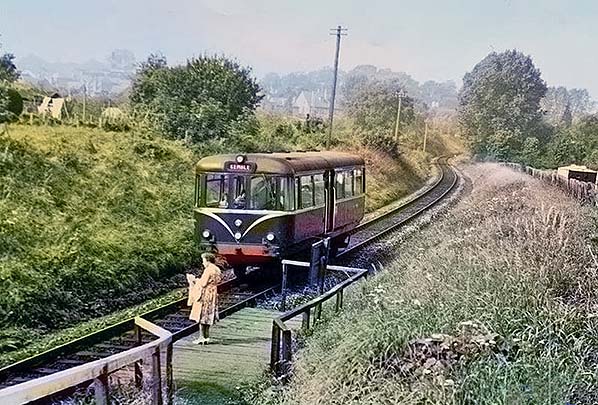
On an unknown date an AC Cars diesel railbus approaches Chesterton Lane Halt where a solitary passenger waits, she having made her way with high-heeled shoes down the cinder path from the road. On what was clearly a very pleasant day, the buildings of Cirencester can be seen in the background. Tickets from the halts were issued by the guard, using the once-very-familiar Setright ticket machines (see example above). Chesterton Lane Halt was a half mile from Cirencester Town station and a mere quarter mile from the town's other station, Watermoor, which the branch from Kemble was destined to outlive.
Photo from Steve Bartlett collection 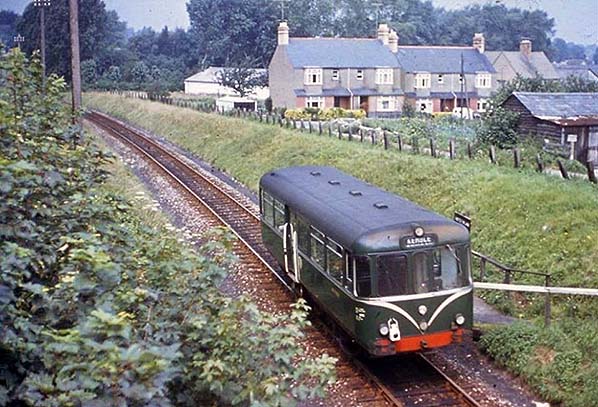 On an unknown date an AC Cars diesel railbus pauses at Chesterton Lane Halt whilst on its way to Cirencester Town. Although the number of the railbus is by no means clear it appears to be W79978, which was destined to be one of two of this type to survive into preservation. The body of a third, SC79979, also survived for many years but was subsequently disposed of. The object on the roof above the driver's cab, far left corner, is the engine exhaust outlet while the boldly painted handrails at the door are part of the retractable steps arrangement for use at halts such as Chesterton Lane.
Photo from Steve Bartlett collection 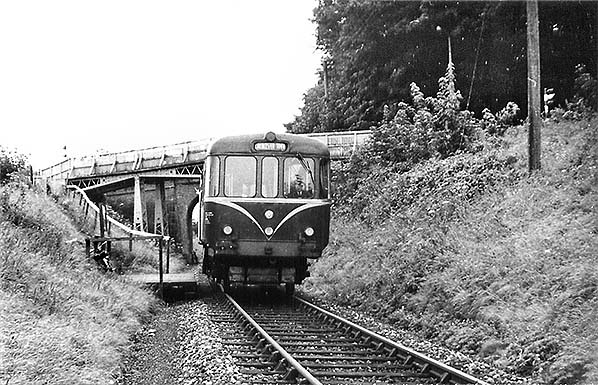
In August 1963 an AC Cars diesel railbus poses for the camera at Chesterton Lane while on its way to Cirencester Town. The retractable steps of the railbus are not deployed and the presence of the bicycle suggests this photograph was deliberately posed, perhaps by earlier arrangement with the crew. The basic structure of the halt is evident; a path down the side of the cutting; some railings; a nameboard; a low platform made from old sleepers. A similar arrangement existed at Park Leaze Halt. Both halts were provided for the railbuses and although the halts were crude, to put it mildly, they were adequate. Chesterton Lane crossed the railway on the brick bridge in the background. At the time the road was narrow, on a dogleg where it crossed the railway and was controlled by traffic signals. For this reason a pedestrian footbridge was provided alongside the road bridge, it being clearly seen behind the railbus. At the time of writing no information on this bridge had come to light, but it was a prefabricated, probably wrought iron, structure. Somewhat elaborate for its purpose at Chesterton Lane, it was possibly of military origin. Perhaps needless to say, after the railway closed this nuisance arrangement was quickly swept away with the dogleg removed and the road widened
Photo from John Mann collection 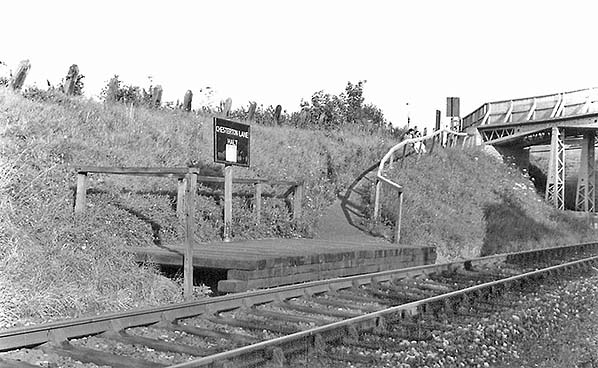
In this undated view of Chesterton Lane Halt the basic construction of the halt is apparent.
Photo from John Mann and Steve Bartlett collection 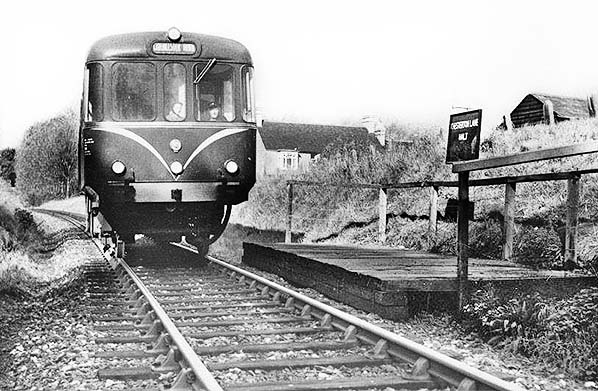
An AC Cars diesel railbus poses approaches Chesterton Lane Halt and then on to Cirencester Town circa early 1960s.
Photo from John Mann and Steve Bartlett collections 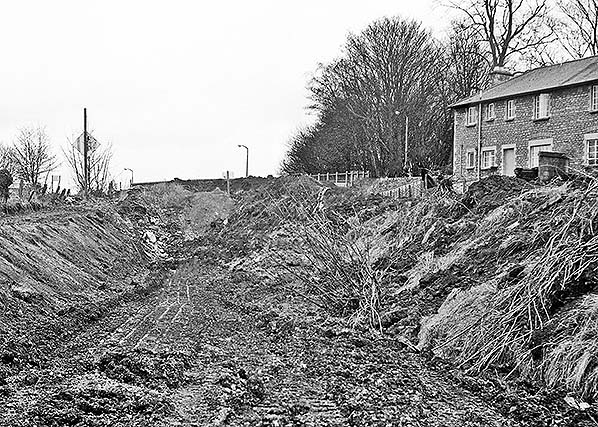
The site of Chesterton Lane Halt looking south a few years after closure. The cutting is in the process of being filled in. Although the wooden halt has been removed the path down from the road can still be seen, now strewn with rubble. The road bridge was still in place at this time but the adjacent footbridge has been demolished-name
Photo from John Mann and Steve Bartlett collections 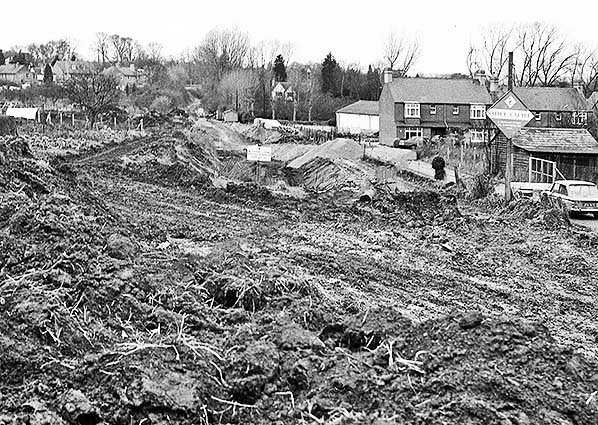 Looking north from Chesterton Lane bridge a few years after closure. The track bed is in the process of being prepared for a anew road.
Photo from John Mann and Steve Bartlett collections 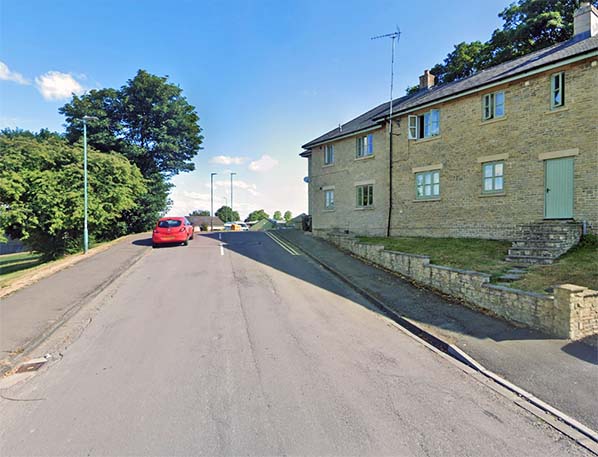
Meadow Road now occupies the site of Chesterton Lane Halt although at a slightly higher level to bring the road up to the level of Chesterton Lane. The houses on the right are seen on several of the old pictures. With the removal of Chesterton Lane bridge the awkward dogleg in the road was also removed.
Photo
by Stella Marame
|
 BRIEF HISTORY OF THE CIRENCESTER BRANCH. The Great Western Railway opened its main line between London and Bristol in 1841. During the construction period, an independent company called the Cheltenham and Great Western Union Railway obtained authorisation on 21 June 1836 to make a line from the GWR at Swindon, to Cheltenham by way of Stroud and Gloucester. As well as the main line between Swindon and Cheltenham, there was to be a branch to Cirencester, terminating at a place there referred to as Botany Bay. A landowner at Kemble, named Robert Gordon, was evidently hostile to the railway, and he secured clauses in the authorising Act requiring a tunnel, not needed for engineering purposes, near Kemble. Moreover the railway was forbidden to open a public station on Gordon's estate. The new line was to be on the broad gauge.
BRIEF HISTORY OF THE CIRENCESTER BRANCH. The Great Western Railway opened its main line between London and Bristol in 1841. During the construction period, an independent company called the Cheltenham and Great Western Union Railway obtained authorisation on 21 June 1836 to make a line from the GWR at Swindon, to Cheltenham by way of Stroud and Gloucester. As well as the main line between Swindon and Cheltenham, there was to be a branch to Cirencester, terminating at a place there referred to as Botany Bay. A landowner at Kemble, named Robert Gordon, was evidently hostile to the railway, and he secured clauses in the authorising Act requiring a tunnel, not needed for engineering purposes, near Kemble. Moreover the railway was forbidden to open a public station on Gordon's estate. The new line was to be on the broad gauge.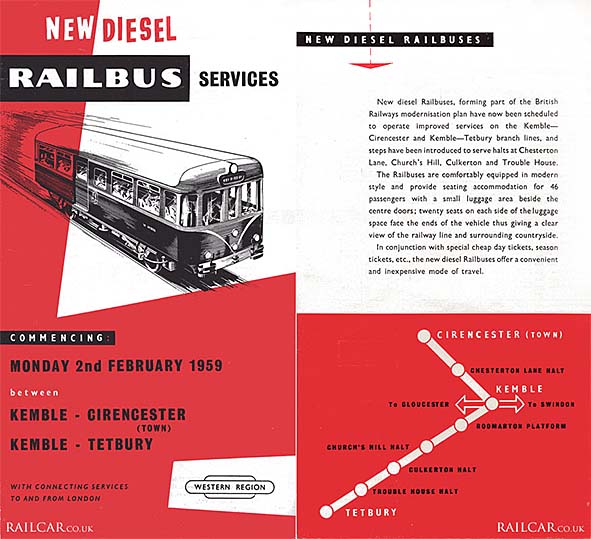
 British Railways ordered 22 passenger railbuses as an attempt to cut operating costs on rural railways and avoid closure. They started operating on the Cirencester line in February 1959. Of those, AC Cars Ltd of Thames Ditton, better known for their upmarket motor cars and the Southend pier railway rolling stock of 1949, won a contract for five railbuses which BR numbered W79975 - 8 and SC79979. AC Cars sensibly chose to install broadly the same equipment as used on the bulk of BR's diesel-mechanical multiple-units; the AEC A220 engine set to develop 150bhp at 1800rpm; fluid flywheel with freewheel; Self-Changing Gears Ltd R14 epicyclic gearbox; axle mounted reverse/final drive unit. Driving controls were of the Sharps type. There were, however, a number of major differences. There were engine controls for, of course, only a single engine and no provision for multiple-unit operation while braking was by compressed air rather than vacuum. Maximum road speed was 57½mph, hardly high speed but perfectly adequate for branch lines. The railbus body seated 46 passengers in two saloons with a central vestibule and as with all BR railbuses there was no separate area for the guard. Entrance doors were sliding, power operated by the driver. On the Cirencester and Tetbury branches it was originally intended to run through services to/from Swindon but this plan was abandoned, where passenger services were concerned, when it was found the railbuses could not be relied upon to operate track circuits. Railbuses did operate in service over main lines on other regions but a special set of strict regulations applied which the Western Region found too disruptive, especially in the vicinity of Swindon. Railbuses stabled overnight at Cirencester and Tetbury, initially running each day empty to Swindon for refuelling. This arrangement was soon altered to a cyclic diagram requiring just one railbus to return to Swindon each day, but as a precaution an emergency fuel supply was set up at Cirencester Town consisting of a 50 gallon drum elevated upon a wooden frame. It is visible in several photographs, opposite the end of the station platform.
British Railways ordered 22 passenger railbuses as an attempt to cut operating costs on rural railways and avoid closure. They started operating on the Cirencester line in February 1959. Of those, AC Cars Ltd of Thames Ditton, better known for their upmarket motor cars and the Southend pier railway rolling stock of 1949, won a contract for five railbuses which BR numbered W79975 - 8 and SC79979. AC Cars sensibly chose to install broadly the same equipment as used on the bulk of BR's diesel-mechanical multiple-units; the AEC A220 engine set to develop 150bhp at 1800rpm; fluid flywheel with freewheel; Self-Changing Gears Ltd R14 epicyclic gearbox; axle mounted reverse/final drive unit. Driving controls were of the Sharps type. There were, however, a number of major differences. There were engine controls for, of course, only a single engine and no provision for multiple-unit operation while braking was by compressed air rather than vacuum. Maximum road speed was 57½mph, hardly high speed but perfectly adequate for branch lines. The railbus body seated 46 passengers in two saloons with a central vestibule and as with all BR railbuses there was no separate area for the guard. Entrance doors were sliding, power operated by the driver. On the Cirencester and Tetbury branches it was originally intended to run through services to/from Swindon but this plan was abandoned, where passenger services were concerned, when it was found the railbuses could not be relied upon to operate track circuits. Railbuses did operate in service over main lines on other regions but a special set of strict regulations applied which the Western Region found too disruptive, especially in the vicinity of Swindon. Railbuses stabled overnight at Cirencester and Tetbury, initially running each day empty to Swindon for refuelling. This arrangement was soon altered to a cyclic diagram requiring just one railbus to return to Swindon each day, but as a precaution an emergency fuel supply was set up at Cirencester Town consisting of a 50 gallon drum elevated upon a wooden frame. It is visible in several photographs, opposite the end of the station platform. 

 Home Page
Home Page